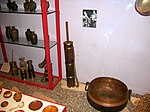
Yak butter (also known as "dri butter" or "su oil" Standard Tibetan: འབྲི་མར།, Chinese: 酥油) is butter made from the milk of the domestic yak (Bos grunniens). Many herder communities in China (including Tibet), India, Mongolia, Nepal, and Gilgit-Baltistan Pakistan produce and consume dairy products made from yak's milk, including butter. Whole yak's milk has about twice the fat content of whole cow's milk, producing a butter with a texture closer to cheese. It is a staple food product and trade item for herder communities in south Central Asia and the Tibetan Plateau.

Production

Yaks provide their herders with many different benefits, including dung for fuel, draught power, meat, fiber, and milk. Not all herding communities have a tradition of using yak's milk or making butter, although in regions of mountain pastures the practice is common. Each individual yak cow produces little milk, so only when large herds are present can herders expect much milk to be obtained. Milk is much more plentiful in summer than winter; turning fresh milk into butter or cheese is a way to store calories for later use.
In western Tibet, yak's milk is first allowed to ferment overnight. In summer, the resulting yogurt-like substance is churned for about an hour by plunging a wooden paddle repeatedly into a tall wooden churn. In winter, yogurt is accumulated for several days, then poured into an inflated sheep's stomach and shaken until butter forms.
Fresh yak butter is preserved a number of ways, and can last for up to a year when unexposed to air and stored in cool dry conditions. It is sewn into sheep-stomach bags, wrapped in yak skin, or wrapped in big rhododendron leaves. Once the container is opened, yak butter will begin to decompose; producing veins of blue mold similar to blue cheese.
The English word "yak" is a loan originating from Tibetan: གཡག་, Wylie: g.yak. In Tibetan, it refers only to the male of the species, who needless to say do not produce milk (a literal translation into Tibetan would be like saying "bull butter"); the female are called Tibetan: འབྲི་, Wylie: 'bri, or nak. In English, as in most other languages that have borrowed the word, "yak" is usually used for both sexes.
Uses

Yak butter tea is a daily staple dish throughout the Himalaya region and is usually made with yak butter, tea, salt and water churned into a froth. It is the Tibetan national beverage, with Tibetans drinking upwards of sixty small cups a day for hydration and nutrition needed in cold high altitudes. Sometimes rancid butter is used, which gives the tea a different taste.
Melted yak butter may be mixed, in roughly equal proportions, with roasted barley flour (tsampa). The resulting dough, mixed with dates or sesame seeds, is used for welcoming guests. It can also be stored for later use and then melted into hot water, to which salt or sugar has been added.
Yak butter is used in traditional tanning of hides. Old, rancid butter is preferred over fresh.
Other non-food uses include fueling yak-butter lamps, moisturizing skin, and the traditional butter sculptures for Tibetan New Year. Such yak-butter sculptures may reach nearly 10 meters in height.
In Nepal, particularly in Kathmandu, yak cheese and yak butter are produced in factories and sold commercially. During 1997–1998, twenty-six tonnes of butter were produced and sold this way in Nepal.
See also
References
- ^ Jordans, Bart (2008). Bhutan: A Trekker's Guide, Cicerone Press Limited. pg. 180.
- ^ Levy, Patricia (2007). Tibet. Marshall Cavendish. pg. 122
- ^ "10 Products from Yak and Their Utilization". FAO. Retrieved 3 July 2011.
- Indra, R (1983). Composition, quality and consumption of yak milk in Mongolia. State University of Agriculture. pp. 46–52.
- ^ Goldstein, Melvin C; Cynthia M. Beall (1990). Nomads of Western Tibet: The Survival of a Way of Life. University of California Press. p. 87. ISBN 9780520072107.
- Marcello, Patricia Cronin (2003). The Dalai Lama: A Biography, Greenwood Publishing Group. pg. 7
- Wiener, G (2003). The Yak. Second edition revised and enlarged (PDF). Food and Agriculture Organization of the United Nations. p. 252.
Leather from yak is usually tanned by a traditional method. For this purpose, the herdsmen ... spread old, rancid butter on the skin (fresh butter is not useful in tanning).
- "Yaks, butter, and lamps in Tibet". WebExhibits.org. Retrieved 3 July 2011.
- "Butter Sculpture Tradition Melting Away". China.org.cn. Retrieved 3 July 2011.
- Goldstein, Melvin C; Cynthia M. Beall (1990). Nomads of Western Tibet: The Survival of a Way of Life. University of California Press. p. 241. ISBN 9780520072107.
- Goldstein, Melvin C; Cynthia M. Beall (1990). Nomads of Western Tibet: The Survival of a Way of Life. University of California Press. p. 317. ISBN 9780520072107.
| Butter | |||||||
|---|---|---|---|---|---|---|---|
| Types of butter |  | ||||||
| Dishes featuring butter |
| ||||||
| Butter paraphernalia | |||||||
| Butter industry | |||||||
| Butter brands |
| ||||||
| Butter in culture | |||||||
| Miscellaneous | |||||||